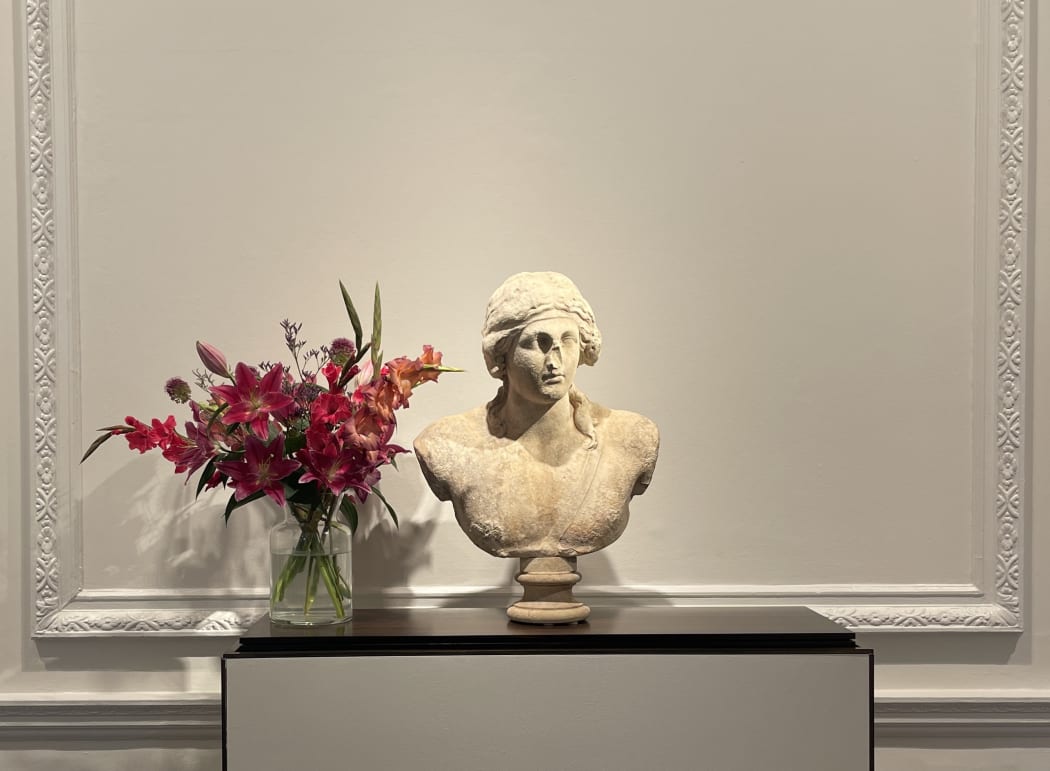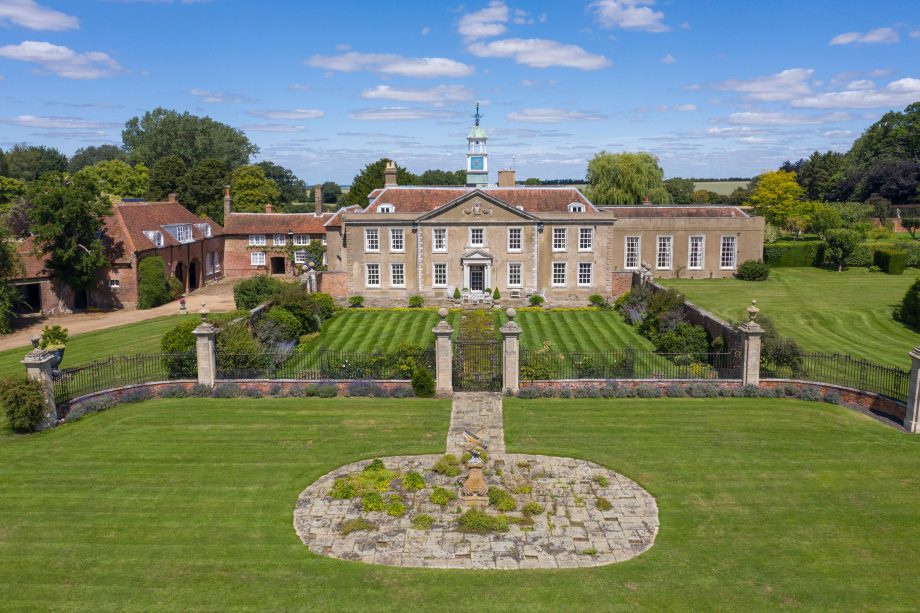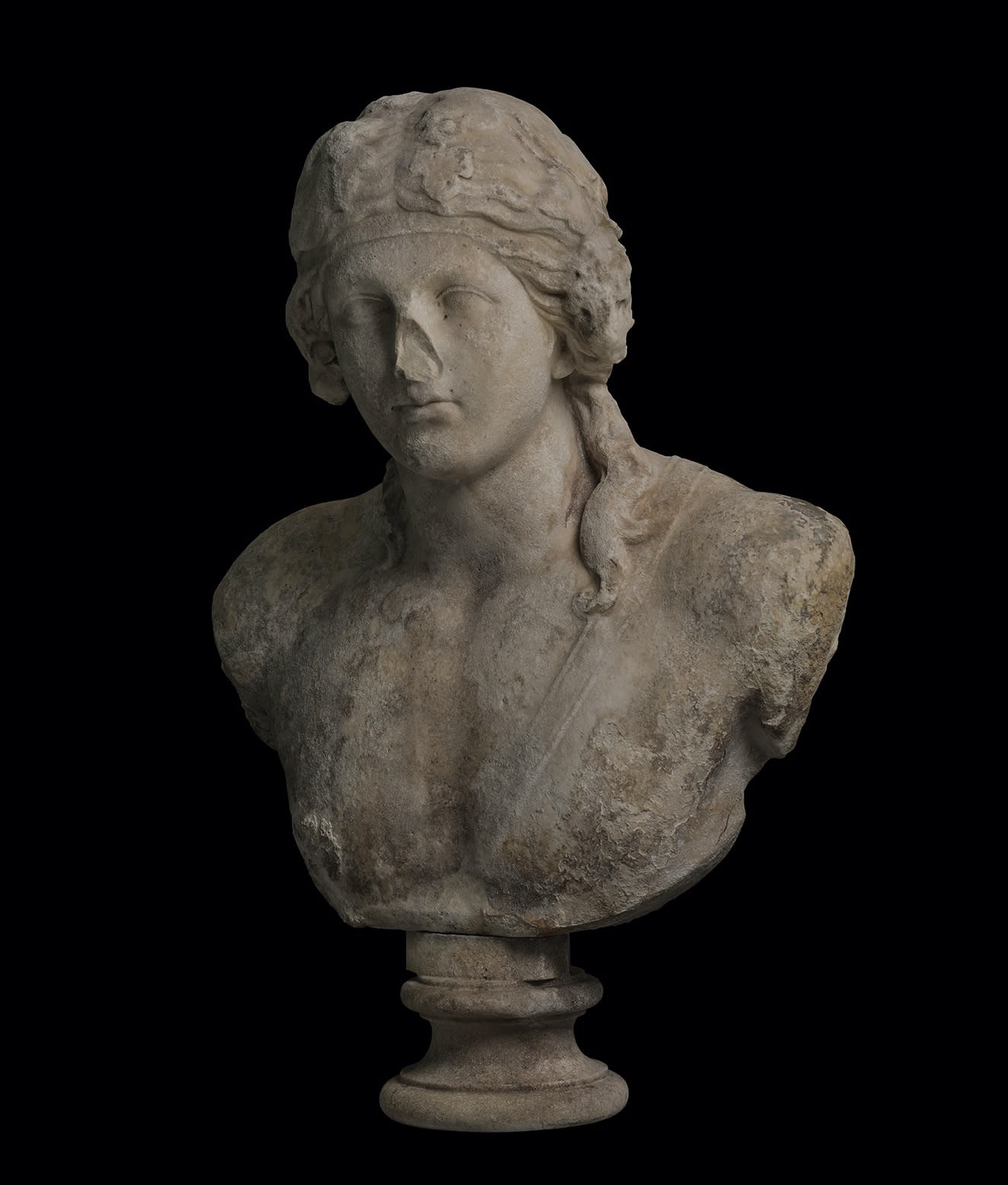THE PLEYDELL BOUVERIE BACCHUS
July 15, 2022
 A LARGE ROMAN MARBLE BUST OF A YOUTHFUL BACCHUS
A LARGE ROMAN MARBLE BUST OF A YOUTHFUL BACCHUSFirst half of the 2nd century AD
Height: 55 cm without socle
This striking over life-size bust of the Roman god of wine and fruitfulness is a recent rediscovery previously in the collection of Audrey Pleydell-Bouverie (1902 – 1968), a transatlantic art collector and society hostess. It is perhaps rather apt that this beautiful bust of the god of revelry was owned by a bright young thing, well-known for her social life, jet-setting between London, Corfu, the French Riviera and New York.
Born Audrey Evelyn-James, the illegitimate granddaughter of King Edward VII, she grew up in Sussex in a house of constant parties, catching the eye of two of the most famous bachelors of her day, the Prince of Wales (and future Duke of Windsor) and Lord Mountbatten, the beloved uncle of the Duke of Edinburgh. Yet she chose Captain Muir Dudley Coats for her husband - a war hero, who tragically died only five years into their marriage. Subsequent husbands were an American department store millionaire, Marshall Field III and the Hon. Peter Pleydell-Bouverie, the son of the Earl of Radnor.

P. HORST PORTRAIT OF AUDREY PLEYDELL-BOUVERIE
In 1936 Audrey acquired The Holme in Regent's Park and set about remodelling the house and gardens under the guiding hand of the decorator Stéphane Boudin of the Parison 'Maison Jansen' who would later go on to remodel the Kennedy White House. Boudin's classicising taste was a critical inspiration for the the interiors, fusing furniture from early 19th century England, France and Italy, alongside sculpture and paintings in what one could term the 'Vogue Regency' style. When Audrey bought Julians Park in Hertfordshire (pictured below), she turned again to Boudin and it is believed that the bust of Bacchus was purchased during this time from Crowther of Syon Lodge. Crowther was a sculpture and architectural salvage specialist through whose hands passed numerous ancient marbles from the finest English collections such as the Cook and Lansdowne Collections, formed during the Grand Tour and sadly dispersed before and after WWII.


The god of fruitfulness, wine and revelry, Dionysus/Bacchus is here depicted in his youthful, and long-haired guise, gazing downwards and crowned with a foliate ivy wreath. This bust is close to the Horti Lamiani and Borghese-Colonna types, both of which are thought to be Roman copies of 4th century BC Greek originals. It was during the Classical Period in ancient Greece that images of Dionysus moved from showing the god as an older bearded man, to a more youthful and idealised portrayal. It has been suggested that this development could be linked to the rise in popularity of the play The Bacchae, and the depiction of the god by Euripides. The corkscrew curls for example, and the looser coiffure are used to express the wild, ecstatic spirit of Dionysus.

The Horti Lamiani type is named after a Roman marble head of Dionysus/Bacchus, now in the Capitoline Museum, that was discovered in the Lamian Gardens, an ancient Roman villa with large gardens and outdoor rooms located on the Esquiline Hill in Rome. See C. Gasparri, ‘Dionysos,’ in LIMC, vol. III, no. 121 and 123. The subject of Dionysus/Bacchus was a popular choice for garden decoration in ancient Rome, both public and private as the god’s association with nature, as well as relaxation and leisure, made him a fitting choice for garden ornamentation. The hortus in a private home or villa was often enhanced with sculptures, fountains, garden furniture, and reflected a ‘blending of Roman and Greek ideas and concepts’ (P. Roberts, Life and Death in Pompeii and Herculaneum, London, 2013, p. 148). This Bacchus would have been as fitting a garden decoration in antiquity, as in the 20th century Pleydell-Bouverie gardens.
The classicising features of his face, the lack of deep drilling in the hair and the bust’s likeness to images of Antinous points to a date in the first half of the 2nd century AD.
Antinous (circa 111-138 AD) was a favourite and the beloved of the emperor Hadrian. After his tragic, premature death, the distraught Hadrian deified his lover and set up a cult in his honour that spread throughout the Empire. Antinous was widely syncretised with the god Dionysus, and some of the most renowned portraits of the handsome youth depict him in the guise of the god crowned with ivy. For example, the ‘Lansdowne Antinous’ found at Hadrian’s Villa in 1769, now in the Fitzwiliam Museum, Cambridge.
Hadrian's passion for Greece meant that he turned to Greek sculptors to create a classical repertoire for depictions of his lover. These sculptures share distinctive features such as a broad, swelling chest, tousled curls and a sensuous downcast gaze, all of which the Kallos bust recall. These features exude the classicising idealism made so famous by Greek artists in the Classical and Hellenistic periods.